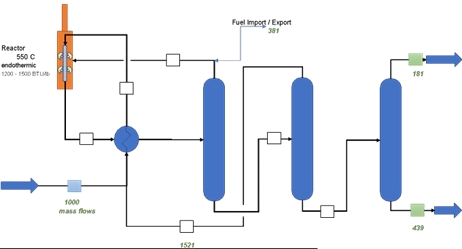Single-Step Conversion Could Lead to Economic Utilization of "Stranded" Gas Components
Outcome/Accomplishment
A single-step process to efficiently convert propane found in shale gas to gasoline and chemicals has emerged from research at the Center for Innovative and Strategic Transformation of Alkane Resources (CISTAR), an NSF-funded Engineering Research Center (ERC) based at Purdue University.
Impact/Benefits
While shale gas is mostly methane, it carries significant propane, ethane, and other hydrocarbons. The new single-step process lowers the required temperatures and capital costs needed to convert the propane to high-octane gasoline or aromatic chemicals, or ethane to ethylene and aromatics. Direct transformation of light alkane into chemicals or fuels also could occur close to where they are produced.
Explanation/Background
: The United States' proven reserves of natural gas have nearly doubled in the past 15 years as a result of technologies to extract gas from shale formations. A sizeable fraction of these reserves are located in remote areas, away from the chemical processing facilities in the East, West and Gulf Coast regions, which requires costly transportation over long distances by a pipeline.
The NSF-funded team at Purdue has demonstrated at the laboratory scale a catalyst and process to convert ethane and propane into transportation fuels. Current ethane/propane-to-aromatics technologies produce far too much methane to be economical.CISTAR researchers were able to significantly reduce gas yield and improve the process economics by separately designing the metal dehydrogenation and acid zeolite functions in the catalyst system. The CISTAR process has attractive economics and could produce gasoline locally near the shale gas wells. One of CISTAR's industrial partners has licensed the patent and is evaluating this technology for commercial implementation.
Location
West Lafayette, Indianawebsite
Start Year
Energy and Sustainability
Energy, Sustainability, and Infrastructure
Lead Institution
Core Partners
Fact Sheet
Outcome/Accomplishment
A single-step process to efficiently convert propane found in shale gas to gasoline and chemicals has emerged from research at the Center for Innovative and Strategic Transformation of Alkane Resources (CISTAR), an NSF-funded Engineering Research Center (ERC) based at Purdue University.
Location
West Lafayette, Indianawebsite
Start Year
Energy and Sustainability
Energy, Sustainability, and Infrastructure
Lead Institution
Core Partners
Fact Sheet
Impact/benefits
While shale gas is mostly methane, it carries significant propane, ethane, and other hydrocarbons. The new single-step process lowers the required temperatures and capital costs needed to convert the propane to high-octane gasoline or aromatic chemicals, or ethane to ethylene and aromatics. Direct transformation of light alkane into chemicals or fuels also could occur close to where they are produced.
Explanation/Background
: The United States' proven reserves of natural gas have nearly doubled in the past 15 years as a result of technologies to extract gas from shale formations. A sizeable fraction of these reserves are located in remote areas, away from the chemical processing facilities in the East, West and Gulf Coast regions, which requires costly transportation over long distances by a pipeline.
The NSF-funded team at Purdue has demonstrated at the laboratory scale a catalyst and process to convert ethane and propane into transportation fuels. Current ethane/propane-to-aromatics technologies produce far too much methane to be economical.CISTAR researchers were able to significantly reduce gas yield and improve the process economics by separately designing the metal dehydrogenation and acid zeolite functions in the catalyst system. The CISTAR process has attractive economics and could produce gasoline locally near the shale gas wells. One of CISTAR's industrial partners has licensed the patent and is evaluating this technology for commercial implementation.

